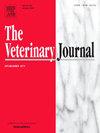Liraglutide as a novel therapeutic for overweight in canines: A clinical study
IF 3.1
2区 农林科学
Q1 VETERINARY SCIENCES
引用次数: 0
Abstract
Background
The overweight/obesity in dogs is defined as a condition of abnormal fat accumulation or, beyond that, a multifactorial condition involving excessive fat accumulation along with different factors (insufficient physical activity, genetics (breed), metabolism, the microbiome, etc.). Preclinical obesity conditions increases the risk of progressing to clinical obesity and developing obesity-associated diseases such as type 2 diabetes, cardiovascular disease, certain cancers, and mental disorders.
Objectives
This study aimed to determine the weight-loss effects of liraglutide in dogs that do not engage in sufficient exercise, are fed table scraps, and develop obesity owing to aging.
Animals
In this study, 21 senior Golden Retriever dogs were divided into three equal groups.
Methods
Group 1 was considered healthy and consisted of dogs within the range of ideal body live weight and body condition scores, and fed dry commercial dog food at the amount of their daily metabolizable energy requirements. Group 2 included seven senior dogs with obesity fed commercial dry food adjusted for their daily metabolizable energy requirements. Group 3 comprised seven senior dogs with obesity fed commercial dry food adjusted for their daily energy requirements and concurrently treated with subcutaneous liraglutide at a dose of 1.2 mg/dog. The trial lasted for 40 days.
Results
Liraglutide treatment resulted in a decrease in body condition score (BCS) and body weight by day 40, although the reduction in body weight (13.27 %) did not reach statistical significance. Liraglutide significantly lowered cholesterol and triglyceride levels, and appetite tests revealed a marked suppression of food intake over consecutive days in treated dogs.
Conclusions and clinical importance
Liraglutide treatment may offer a viable option for treating obesity in dogs, and could potentially be used as a new anti-obesity drug in canines. Future long-term and detailed trials of liraglutide in dogs with obesity could facilitate its effective use in the field.
利拉鲁肽作为一种新的治疗犬超重的药物:临床研究。
背景:狗的超重/肥胖被定义为一种异常脂肪积累的状况,除此之外,还包括脂肪过度积累以及不同因素(体育活动不足、遗传(品种)、代谢、微生物群等)的多因素状况。临床前肥胖状况增加了发展为临床肥胖和发展为肥胖相关疾病(如2型糖尿病、心血管疾病、某些癌症和精神障碍)的风险。目的:本研究旨在确定利拉鲁肽对缺乏足够运动、以残羹剩饭为食、因衰老而肥胖的狗的减肥效果。动物:在这项研究中,21只老年金毛猎犬被分成三组。方法:第一组为健康犬,在理想体活重和体况评分范围内,按犬日代谢能需用量饲喂干型市售狗粮。第二组包括7只肥胖的老年狗,喂养根据其每日代谢能量需求调整的商业干粮。第三组为7只肥胖的老年犬,喂养根据每日能量需求调整的商业干粮,同时皮下注射利拉鲁肽,剂量为1.2mg/只。试验期40 d。结果:利拉鲁肽治疗后第40天体况评分(BCS)和体重下降,但体重下降(13.27%)无统计学意义。利拉鲁肽显著降低了胆固醇和甘油三酯水平,食欲测试显示,在连续几天的治疗中,狗的食物摄入量明显受到抑制。结论及临床意义:利拉鲁肽治疗可能为治疗犬类肥胖提供了一种可行的选择,并有可能作为一种新的犬类抗肥胖药物。未来利拉鲁肽在肥胖狗身上的长期和详细试验可以促进其在该领域的有效使用。
本文章由计算机程序翻译,如有差异,请以英文原文为准。
求助全文
约1分钟内获得全文
求助全文
来源期刊

Veterinary journal
农林科学-兽医学
CiteScore
4.10
自引率
4.50%
发文量
79
审稿时长
40 days
期刊介绍:
The Veterinary Journal (established 1875) publishes worldwide contributions on all aspects of veterinary science and its related subjects. It provides regular book reviews and a short communications section. The journal regularly commissions topical reviews and commentaries on features of major importance. Research areas include infectious diseases, applied biochemistry, parasitology, endocrinology, microbiology, immunology, pathology, pharmacology, physiology, molecular biology, immunogenetics, surgery, ophthalmology, dermatology and oncology.
 求助内容:
求助内容: 应助结果提醒方式:
应助结果提醒方式:


